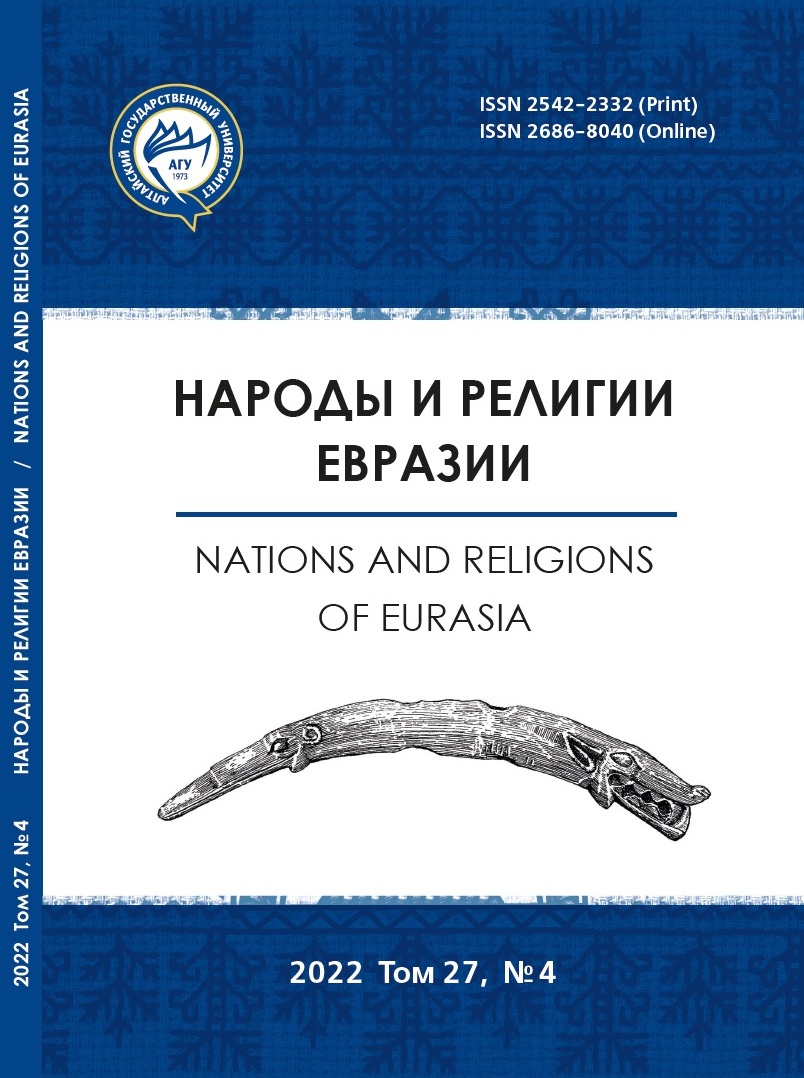About rare types of bits and cheek-pieces of the 11th-12th centuries from Volga Bulgaria (to the question of ethno-cultural contacts)
Main Article Content
Abstract
The article deals with rare types of medieval iron bits and cheek-pieces. They were found at the archaeological sites of the Volga Bulgaria of pre-Mongol times. Despite the fact that the material culture of the Volga Bulgaria has been studied for more than 100 years, the items of horse equipment have not been studied enough. The classification of the bits was made by F. Sh. Khuzin based on materials from the Bilyar hillfort and E. P. Kazakov based on finds in settlements located in the lower reaches of the Kama. However, we are considering bits that have no absolute analogues, both among the antiquities of the Volga Bulgaria, including those that were published, and neighboring territories. A comparative analysis showed that this type of bit is not found in the Bulgar burial grounds of the 8th- 10th centuries, as well as in the settlements of the 13th-14th centuries. Therefore, the date of their manufacture and use can be determined between the 11th and 12th centuries. The presence of characteristic details of decor suggests that the upper limit of their existence is the second half of the 11th century. The closest analogies to the considered artifacts are found in Southern Siberia. Details from horse headbands, which could have such bits, have also been studied. The author claims that the Bulgars in the 11th-12th centuries used two types of headband — with round disks with three holes as belt distributors and rings with three clips in the same capacity. As in the case of bits, the closest analogies to them are found in the materials of Southern Siberia.
Downloads
Metrics
Article Details

This work is licensed under a Creative Commons Attribution 4.0 International License.
References
Горбунова Т. Г. Реконструкция конского снаряжения средневековых кочевников Алтая: методика и некоторые результаты. Барнаул : Азбука, 2010. 136 с.
Казаков Е. П. Булгарское село Х-XIII веков низовий Камы. Казань : Тат. кн. изд-во, 1991. 176 с.
Казаков Е. П. Культура ранней Волжской Болгарии (этапы этнокультурной истории). М. : Наука, 1992. 335 с.
Кирпичников А. Н. Снаряжение всадника и верхового коня на Руси IX-XIII вв. Л. : Наука, 1973. 140 с.
Король Г. Г. Искусство средневековых кочевников Евразии. Очерки // Труды Сибирской Ассоциации исследователей первобытного искусства. Кемерово : Кузбассвуз
издат, 2008. Вып. V. 332 с.
Кызласов И. Л. Аскизская культура Южной Сибири. X-XIV вв. // Свод археологических источников. 1983. № Е3-18. 126 с.
Мажитов Н. А. Курганы Южного Урала VIII-XII вв. М. : Наука, 1981. 164 с. Могильников В. А. Кочевники северо-западных предгорий Алтая в IX-XI веках. М. : Наука, 2002. 362 с.
Мурашова В. В. Поясной набор // Древняя Русь. Быт и культура. М. : Наука, 1997. С. 79-80.
Плетнева С. А. На славяно-хазарском пограничье. Дмитриевский археологический комплекс. М. : Наука, 1989. 288 с.
Полякова Г. Ф. Изделия из цветных и драгоценных металлов // Город Болгар. Ремесло металлургов, кузнецов, литейщиков. Казань : ИЯЛИ АН РТ, 1996. С. 154-268.
Руденко К. А. Железные изделия с инкрустацией из Волжской Булгарии XI-XII вв. // Пензенский археологический сборник. Вып. 5. Пенза : Институт регионального развития Пензенской области, 2022. С. 203-225.
Руденко К. А. Материальная культура булгарских селищ низовий Камы XI-XIV вв. Казань : Школа, 2001а. 244 с.
Руденко К. А. Тюркский мир и Волго-Камье в XI-XII вв. (археологические аспекты проблемы) // Татарская археология. 2000. № 1-2 (6-7). С. 42-102.
Руденко К. А. Тюркский мир и Волго-Камье в XI-XIV вв. Изделия аскизского круга в Среднем Поволжье. Исследование и каталог. Казань : Заман, 2001. 256 с.
Седова М. В. Ювелирные изделия древнего Новгорода (Х-XV вв.). М. : Наука, 1981. 196 с.
Халикова Е. А., Халиков А. Х. Ранние венгры на Каме и Урале (Больше-Тиганский могильник). Казань : Фэн, 2018. 144 с.
Хузин Ф. Ш. Снаряжение всадника и верхового коня // Культура Биляра. Булгарские орудия труда и оружие Х-XIII вв. М. : Наука, 1985. С. 193-213.
Шполянский С. В. Предметы вооружения и конского снаряжения X — первой половины XII в. из Суздаля и сельских поселений Суздальского Ополья // Российская археология. 2017. № 1. С. 150-167.

